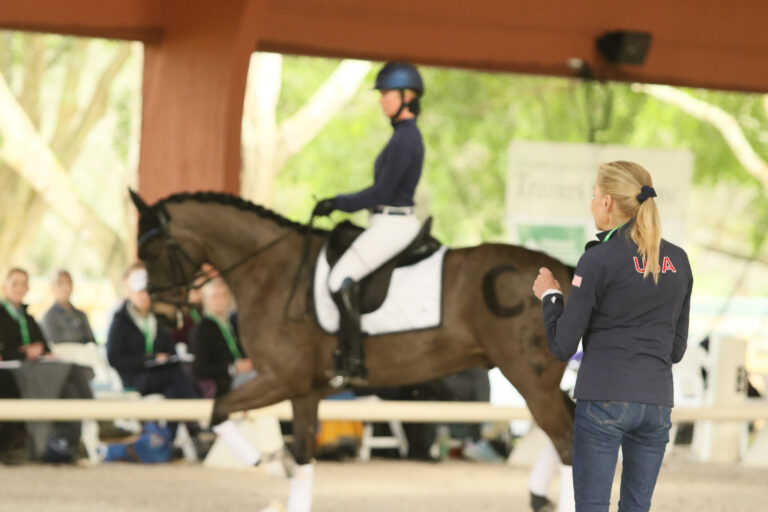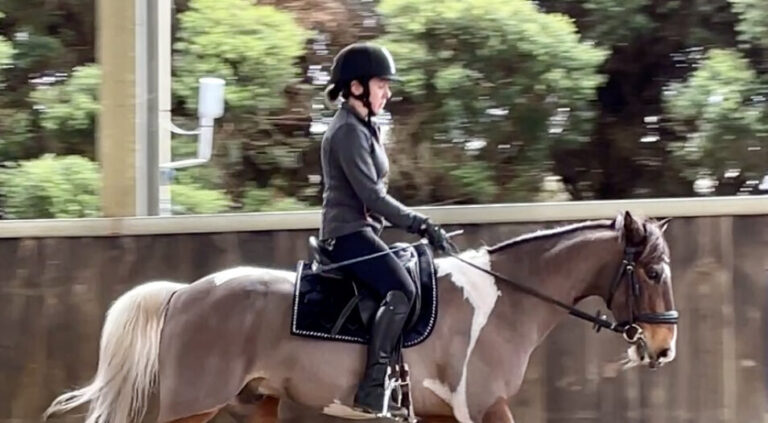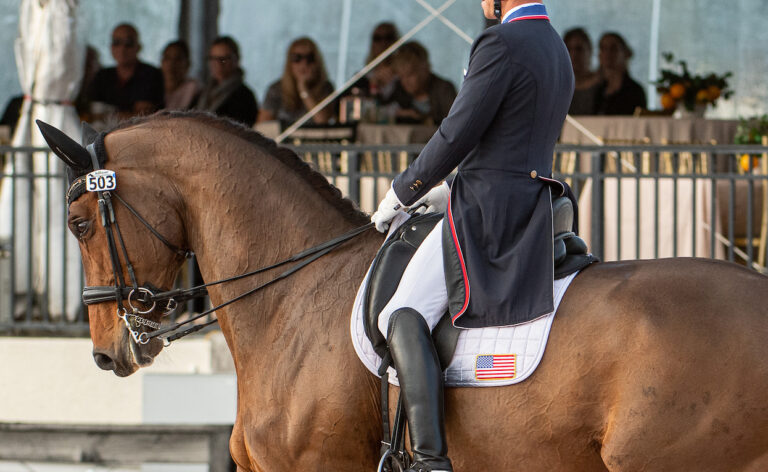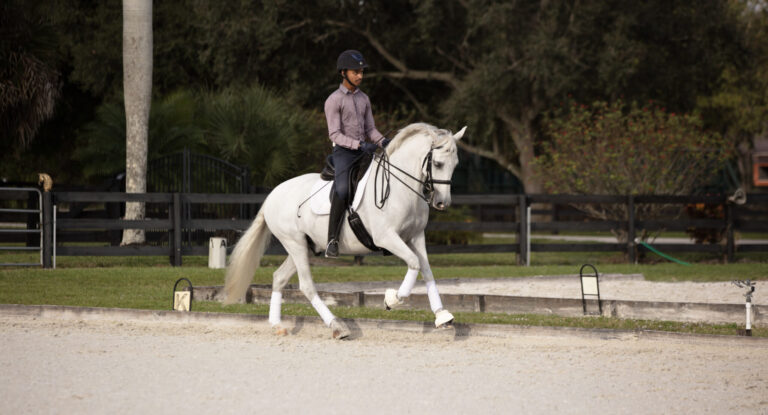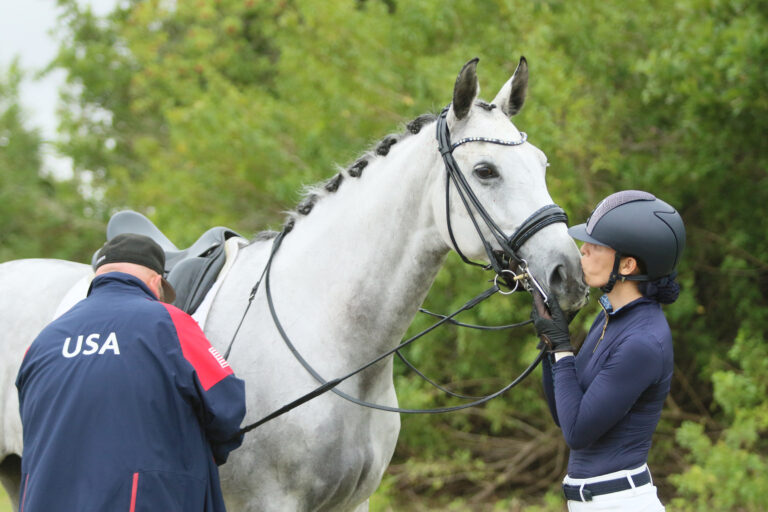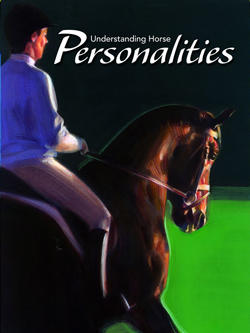Suppleness should be part of your horse’s training right from the beginning. To make your horse supple, he first needs to feel relaxed. He should have a soft mouth and be obedient to your aids. You also want to feel throughness, which to me means being able to easily bend the horse’s whole body left and right as well as ride forward and back. (See the definition of “throughness” below.) All these ingredients work together to create suppleness.
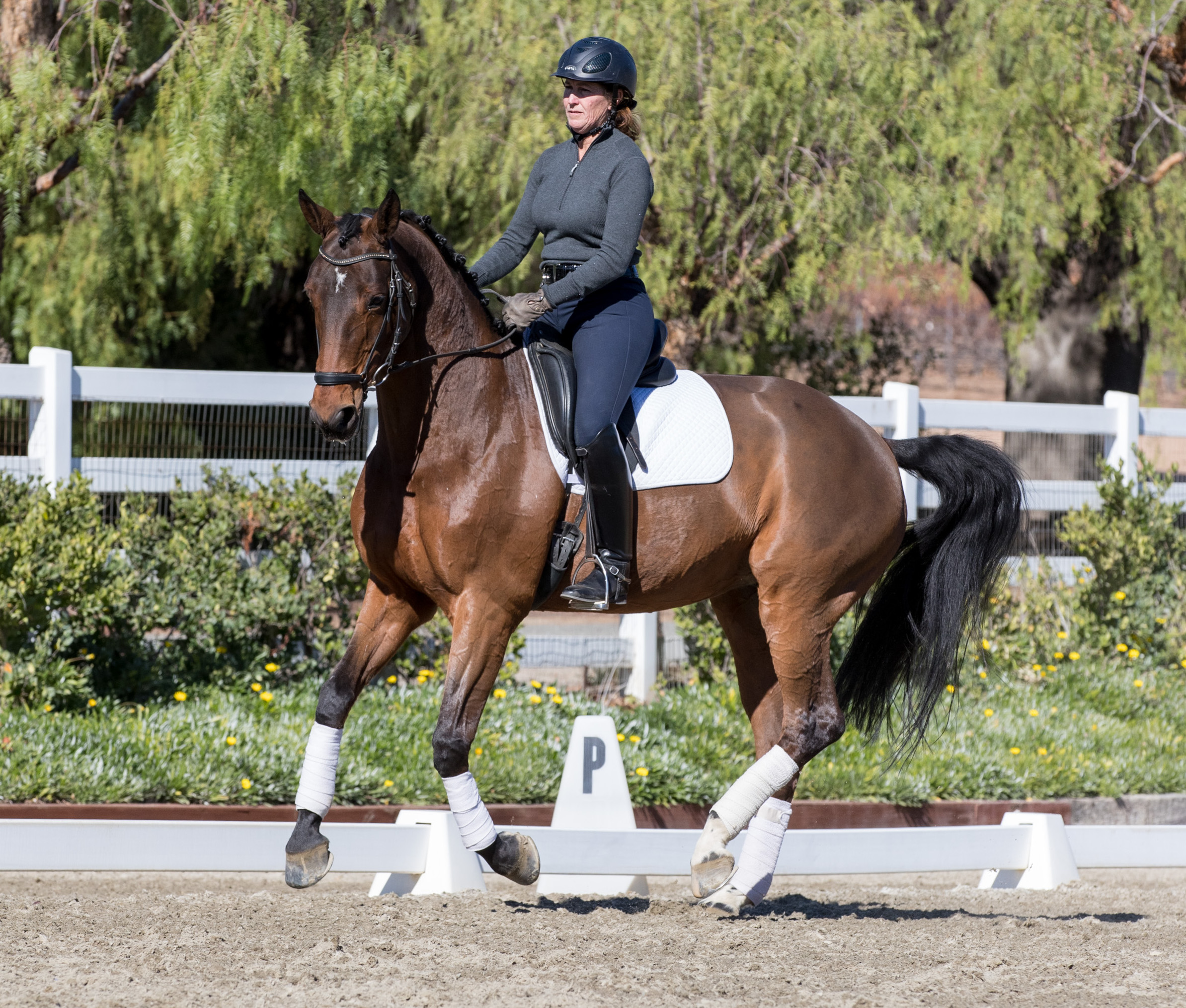
You know your horse is supple when he willingly accepts your aids with his soft mouth, his muscles are loose, he’s able to stretch forward and down and he feels balanced, using his joints actively. A supple horse has a relaxed look to his eyes, ears, mouth and tail. His back swings and he is focused on the rider’s aids. He can drop his neck and easily stretch to the contact when asked because his hind legs maintain the balance. You will know when his back is swinging because you can feel it is soft, not stiff, and it gives you a comfortable place to sit.
As the horse becomes more advanced and more supple, he is able to use his body more actively, bending his joints and being able to carry more behind and with more engagement as he moves up the levels. Everything comes back to the basics and then it is just a matter of degrees of suppleness as you move up the levels.
Correct basic training includes suppleness right from the beginning because the horse needs to learn how to use his body, no matter what level he is doing. To be in tune with your aids, he must be mentally submissive. To accomplish this, think “relaxation” not “force” when you give an aid. You want his muscles working with you rather than against you.
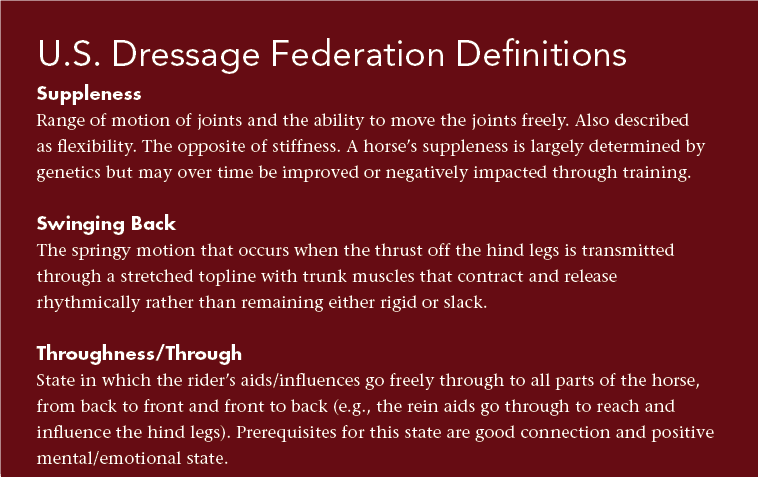
Creating Basic Suppleness
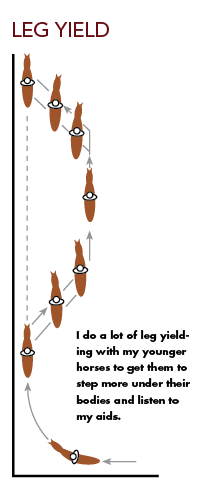
These basic exercises are probably not new to you, but they are the backbone of dressage training at all levels and are the key to creating suppleness. On your next ride, look at them in a new light. Ask yourself if your horse is performing them easily and in relaxation. If your horse speeds up or slows down, for example, or he pulls when you use your rein aid, work toward a soft mouth and gentle bending throughout the body as he responds to your aids. Check your position and balance, too. Remember not to drill the horse or ride him to exhaustion. Always end on a positive note.
Leg yield. I do a lot of leg yielding with my younger horses to get them to step more under their bodies and listen to my aids. There are many places to do leg yield. This is just one.
- Begin by walking straight down the long side, tracking right.
- With the outside, in this case the left rein, ask the horse to flex to the outside, slightly away from his direction of travel.
- Keep him moving forward with your right leg and with your left leg ask for a step sideways toward the center of the arena. Use a leading right rein. When he takes a step as asked, relax and let him go straight forward (parallel to the long side) again.
- Repeat and then do the same in the opposite direction.
Circles. I ride circles left and right to get my horses to bend equally in both directions without changing the rhythm.
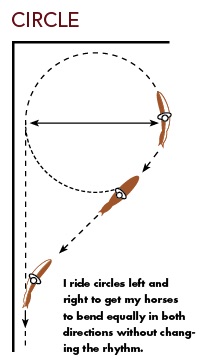
- Circles at this level are about 20 meters in diameter. Mark off the four points of your circle to make sure you are riding a real circle and not a loop or egg shape.
- Use your reins and legs to keep the horse on the correct arcing shape around the circle. Be careful not to overbend him.
- Begin and end the circle at precisely the same place each time. Vary the places you perform circles.
- Keep the tempo steady going into, during and out of each circle.
Change of bend. In my daily routine, I change the horse’s bend using serpentines and leg yields with horses at all levels to get that swinging looseness in the back. The feel for this takes time to learn, but when you get this feeling, it gives you a nice place to sit.
- Ride multiple changes of rein through half circles—bending the horse’s body one way and then to the other for the new circle.
- Ride a lot of serpentines. They teach the horse to bend around your inside leg and connect to your outside rein. You don’t want him to just bend through the neck. You want an even bend throughout his body. When riding a tense horse, make sure you let him take a breath during the work so he has a chance to relax. Some horses hold their breath when they are tense, so pay attention to the breathing. You can hear it. Serpentine work helps to relax a tense horse through his body because of the frequent changes of bend. You want the horse listening to your inside leg and connected to your outside rein in both directions.
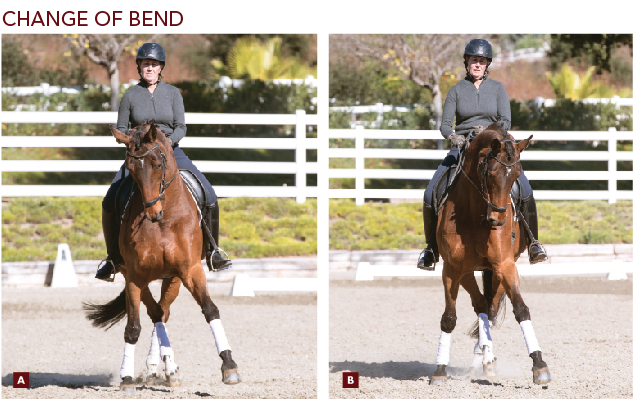
Transitions. These should always look smooth and easy for the horse. Performing transitions will show you if your horse is in tune with your aids and if he is relaxed through his body. Straightness is particularly important. Suppleness will develop during transition work from one pace to another and within the paces.
- Start with walk–halt–stand–walk. When you halt, if you are riding a tense horse, let him stand for a moment and take a breath. Then ask him to walk on. For a lazy horse, you want him to anticipate moving forward. So you wouldn’t do a lot of walk–halt exercises, but when you do, halt and then go forward right away so he is anticipating going forward.
- Next, ride walk–trot–walk and then trot–canter–trot transitions.
More Advanced Suppleness Exercises
I do the same exercises for more advanced horses, but I add elements like shoulder-in and walk–canter–walk transitions to increase the engagement.
During shoulder-in, the horse is slightly bent through his body away from the direction of movement with his outside shoulder in line with his inside hind leg. The horse learns to step under his body with that inside hind leg to develop suppleness and collection.
Here are some cool combos to try:
- Do trot–walk–trot transitions while maintaining shoulder-in. This gets the horse really connected from the inside leg to the outside rein.
- Just after a corner, as you head down a long side, ask for leg yield and ride diagonally across the arena (see photos below). At about the quarterline, change the bend to half pass and then change back again to leg yield. In this variation you change the bend while going in the same direction. This suppling exercise asks the horse to give through his whole body.
- On the diagonal line K–X–M, ride a medium trot. Then, at the end of the diagonal just before M, transition to collected trot and ask your horse for shoulder-fore left. This exercise asks him to engage his new inside hind leg. Be sure to do this in both directions.
- At canter, I like to be able to flex the horse’s head and neck in a new direction and back again without changing the lead. Doing this teaches him to be supple in his body and wait for my leg aid, which is the signal for the change of lead, and he learns to be honest to my leg.
- This is part of training the canter zigzag: Ride half pass right at canter across the diagonal (K–M). Near the centerline, change the bend to shoulder-fore left for a few strides and then back to right half pass. Repeat on the other rein. This exercise again teaches the horse to wait instead of changing direction or lead.
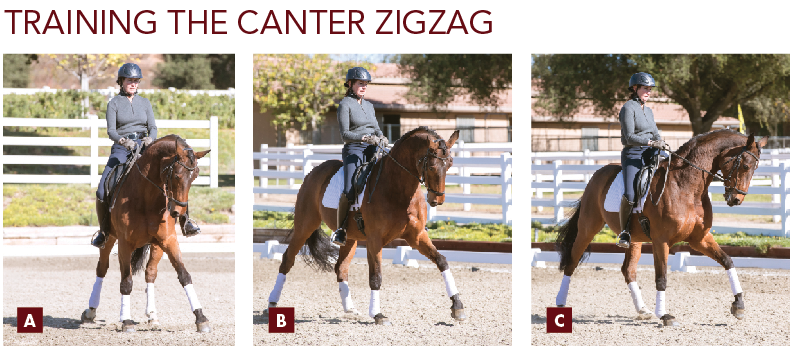
6. Continue training the canter zigzag with this exercise:
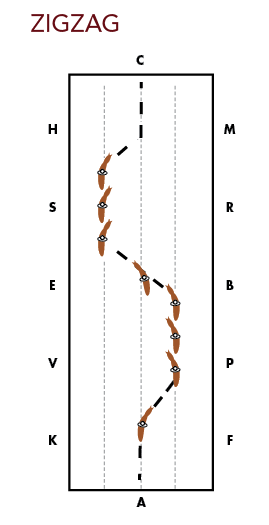
- Canter straight down centerline on the left lead for two or three strides.
- Ride half pass left for two or three strides and then
- Ask for shoulder-fore right for several strides while maintaining the left lead.
- Now ask for a flying change to the right lead and ride two or three strides straight ahead, then
- Ride half pass right for two or three strides,
- Change to shoulder-fore left for several strides before
- Asking for a flying change to the left lead.
The reason for this exercise is to work on the horse not anticipating the change and keeps him listening to you. He must be supple or he can’t respond to your aids. If he isn’t supple, he is against you and takes over.
7. Here is a great exercise I use to create suppleness and improve the canter pirouette: I ride haunches-in on an 8-meter circle. My horse’s body is bent around the circle but his haunches are slightly inside the circle. Then, with my inside leg I push the haunches slightly out. I am still on the same circle but the haunches are making a slightly larger circle than the shoulders. Then I go back to haunches-in and so forth. When the circle is smooth, meaning that it doesn’t get smaller or larger and you can control the size, you know your horse is really supple and on your aids. This exercise keeps the horse loose in his back and he is more easily able to carry you in the collection needed for the canter pirouette.
So you see how important suppleness is at all levels of training. Right now I have young horses whom I enjoy riding and I’ll see how far they want to go. I enjoy competing internationally and maybe they will take me there. I’ve learned that it pays to listen to the horse. Breanna, my current Grand Prix horse, is 17 and still going strong. I always like to keep in mind my longtime trainer (and German master trainer) Johann Hinnemann’s key phrase: Suppleness is the key to success.
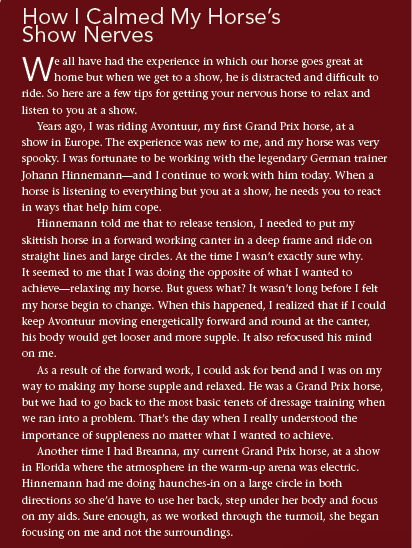

Kathleen Raine is a 1994 World Equestrian Games team-bronze medalist and an FEI Nations Cup team-silver medalist. She was an Olympic dressage team alternate in 1996 and 2000, has been on several successful FEI Nations Cup teams and has ridden in two World Cup Finals. Raine grew up in an equestrian family in Palos Verdes, California, where she attained an “A” Pony Club ranking. At age 18, she went to work for dressage Olympian Hilda Gurney for five years. During that time, she acquired the unbroken 3-year-old warmblood Avontuur. She trained him all the way up the levels and he became her first Grand Prix horse and international/U.S. Equestrian Team partner. He lived with her until his passing at age 32. Also at this time she met fellow trainer David Wightman and in 1990 the couple married and went on to establish their own successful teaching and training business, Adventure Farm, moving it to Murietta, California, in 2001. It was Wightman who spotted the 4-year-old Breanna at the 2004 annual Elite Hanoverian auction in Germany, and with client Jennifer Mason’s help, the mare was purchased for Raine. She and Breanna have gone on to accumulate numerous national and international awards.


